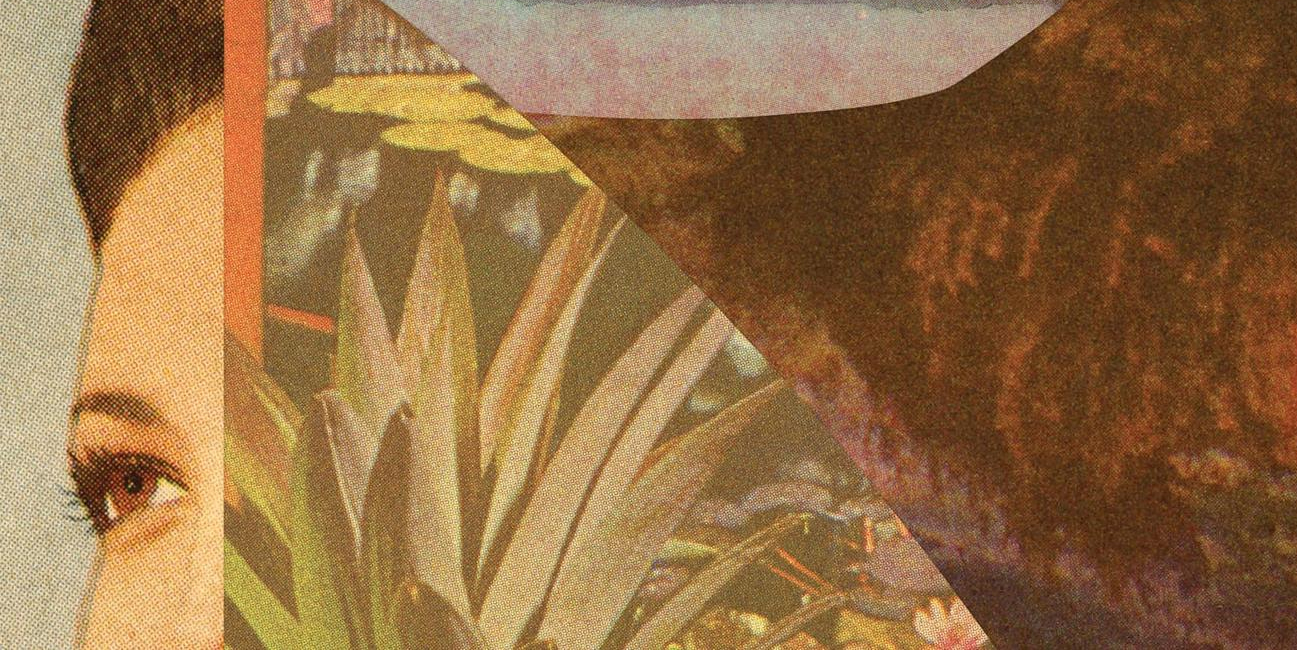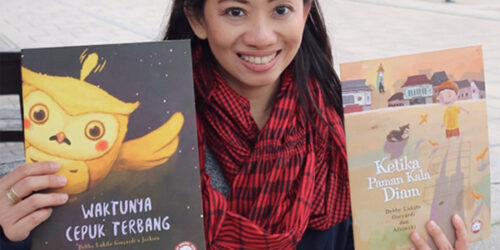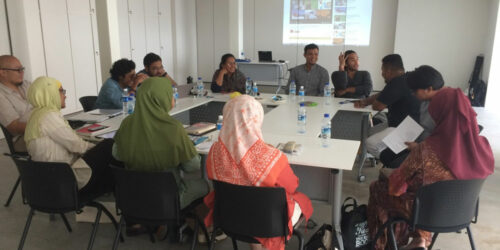
This year’s Market Focus at London Book Fair is Indonesia; introducing the country’s “17,000 Islands of Imagination” to the international public and symbolising the intellectual and artistic richness of this incredibly diverse and multi-religious nation. To celebrate this, each Friday in the run-up to LBF we will be posting a feature on Indonesian literary translation taken from back issues of our translation journal, In Other Words.
Our first read is by literary scholar and translator Pamela Allen, writing about the issues faced by Lontar and its Modern Library of Indonesia. This article was originally published in the Winter 2017 issue of In Other Words (Issue 50) , which focused on Translation and Modern Classics.
This blog was first published with the title ‘Where are all the Indonesian writers’. The National Centre for Writing acknowledges that this title led to a misunderstanding of the intent of the article. We have now changed it back to the original title used in In Other Words on 5 March 2019. The original blog has generated a valuable and timely discussion, including this article in the Jakarta Globe.
While it is now generally unfashionable to speak of a literary “canon,” when a translator comes to selecting works for translation into another language, that process inevitably involves making judgements about what is good literature and writing, which often then leads to the kind of ranking that is the basis of canon-making. It is a process that was faced by Lontar, the Jakarta-based foundation and publishing house, when, in the Modern Library of Indonesia project headed up by John McGlynn, it set itself the goal of both “preserving nearly-forgotten classics of Indonesian literature” and presenting them, often for the first time in English, to an international audience. Books in the Library range from titles such as the 1922 classic Sitti Nurbaya by Marah Rusli (trans. by George A. Fowler), a powerful depiction of the tension between tradition and modernity in the East Indies, to Leila S. Chudori’s 2012 novel Home (trans. by John McGlynn), a story about the tragedy of political exiles during Suharto’s regime (1965-1998) who were forced out of Indonesia after the 1965 massacre of presumed leftists and sympathisers.
Not everyone will agree with the books selected so far—and those that will be selected in the future—but there’s no doubt that most contemporary Indonesian writers would like to see their work included in that Library. Dewi Lestari, for example, as quoted by Alison Kroulek in her blog (Alison Kroulek ), called the English translation (by Harry Aveling) of her 2001 novel Supernova a “dream come true,” adding that the lack of a translation had made it more difficult for her to progress in her writing career.
For me, a long-time scholar and translator of Indonesian literature, seeing the library of translated “classics” on my bookshelf, neat brown spines all in a row, never fails to give me a thrill. But how many other readers have those volumes on their bookshelf? While Lontar has produced, and continues to produce, an exciting library of translated literature, the invisibility of translated literature from Indonesia is often remarked upon.
As Ron Witton reminds us in his review of the Modern Library in Inside Indonesia (28 September 2015), until the flurry of translation activity leading up to Indonesia being Guest of Honour at the 2015 Frankfurt Book Fair, translations of Indonesian literature were relatively rare. This has created the (erroneous) perception that Indonesia doesn’t produce good fiction. For example, as reported in The Jakarta Globe, the high-profile Indonesian writer Putu Wijaya—whose 1973 novel Telegram (translated by Stephen Epstein) is included in the Modern Library series—related that in 1985 “[a]n American man approached me and asked if I was from the Philippines. When I said I was from Indonesia, he was surprised and said he didn’t know there were writers in Indonesia.”
Engaged Literature
A number of factors may have contributed to this relative invisibility of Indonesian literature and to the apparent dearth of translations. One of those factors, I would argue, is the orientation and purpose of serious literature in Indonesia. Ever since the “beginning” of modern Indonesian literature in the early 20th century, Indonesian writers have engaged with the project of creating and defining Indonesian identity, an endeavour that developed out of the nationalist movement. Literature has come to be understood as not merely a product for consumption and entertainment, but as a significant part of the project of nation building. Most serious fiction writers have therefore engaged both with the mission of creating a new literature, and with the interrogation of issues of national identity. This trend continues to inform Indonesian literature in the 21st century. As a result, Indonesian literature is very much—and unapologetically—a literature of and about Indonesia. While as an academic I delighted in this fact, using novels, short stories and even poetry as texts from which my students could learn about the country, its history and its struggles, a reader coming “cold” to one of those same works in translation may feel that they have pitched up mid-conversation, that they need to go away and learn about Indonesia before embarking on the story in question. This is not necessarily a bad thing, of course, and many people have told me that they have done just that, but it means that a full appreciation of many literary works from Indonesia is in some ways contingent upon an understanding of socio-political context.
In order to fully grasp the significance of Mochtar Lubis’s 1963 novel Twilight in Jakarta (trans. by Claire Holt), for example, which depicts the moral decay of Indonesian society from 1945 to 1967 under the charismatic yet deeply flawed President Sukarno, the reader needs the kind of contextual background provided by David Hill in the introduction to the Modern Library revised translation. But even that six-page introduction can only touch the surface of the extraordinarily complex socio-political issues faced by Sukarno and his people at the time. Mochtar Lubis, too, was a complex character, and much of that complexity is transferred to the pages of the novel. Can a reader who knows little about Sukarno’s Indonesia and even less about Mochtar Lubis read this novel in the same way as an Indonesian or a student of Indonesia reads it? (Of course, one might add, does it matter?)
“When I said I was from Indonesia, he was surprised and said he didn’t know there were writers in Indonesia.”
The corollary of this is that, by and large, Indonesian writers write with an Indonesian audience in mind, any desire to be translated into English or other languages notwithstanding. The tension, then, between writing for, of and about Indonesia (with all the assumed knowledge that goes with it) and the desire to be read by an international audience has contributed, I think, to the difficulty Indonesian literature has faced in getting traction in the English-speaking world. While I have great sympathy for Lawrence Venuti’s perspective, outlined in his 2008 book The Translator’s Invisibility, that “a translated text should be the site where a reader gets some sense of a cultural other,” for many readers that “cultural otherness” is too confronting, too complex or just plain too hard.
However, there is mounting evidence that translations of Indonesian literature are being recognised outside Indonesia and the immediate region. Putu Oka Sukanta’s collection of stories Lies, Loss, and Longing (translated by Vern Cork, Leslie Dwyer, Keith Foulcher, John McGlynn and Mary Zurbuchen), which is included in the Modern Library collection, along with Afrizal Malna’s poetry anthology Anxiety Myths (translated by Andy Fuller), were included on World Literature Today’s list of 75 Notable Translations of 2014. In 2015 that list included Leila S. Chudori’s novel Home and Annie Tucker’s translation of Eka Kurniawan’s novel Beauty is a Wound. (Eka’s novel has also been translated into more than 30 other languages.)
There can be no denying that Eka Kurniawan is Indonesia’s most recent literary sensation. Beauty is a Wound has had a significant international impact and won a swathe of literary awards in 2015. This was followed up by his second novel Man Tiger (translated by Labodalih Sembiring) being long-listed for the Man Booker International Prize, the first Indonesian literary work to be awarded that honour. Comparisons have been made between Man Tiger, whose main character is possessed by the spirit of a white tiger, and the magic realism of Latin American writers like Gabriel García Márquez.
But for Eka the road to international recognition was a long one: 14 years between his novels’ publication in Indonesian and their English translations. As Eka told Dene Mullen in a January 2017 interview for Southeast Asian Globe, “Indonesian literature is kind of obscure in, say, a global literary scene, so it’s not easy.” In some ways, the popularity of Beauty is a Wound came as a surprise to scholars of Indonesian literature, not because of any flaws in the quality of the writing or the translation, but precisely because of the issue I raised above, the fact that this novel is deeply embedded in Indonesian history and local mythology. The commercial success of Beauty is a Wound comes back, perhaps, to the multiple layers of meaning in the novel. To one reader it is a highly symbolic retelling of Indonesia’s colonial past, to another it is a flight of surrealist fancy, to yet another it is a poignant love story. Is one reader’s story more valid than another’s? Does the fact this novel is not wedded to a realist depiction explain the way it has leapt the cultural divide between its original and its translation?
Colonial Legacy
Some, including John McGlynn, have commented on Indonesia’s colonial legacy as a contributing factor in the relative invisibility of Indonesian literature, and the difficulties of establishing a market for translation. Authors from the former colonies of France and England, for example, can command the attention of large French or British publishers. Big publishing houses such as Heinemann and Penguin have translated and published authors from India, Kenya, Senegal, Egypt and Morocco. By contrast, Dutch publishers rarely publish literary works from their former colonies, including Indonesia. John McGlynn points out that hardly any foreign publishers will publish translations of anything other than bestselling or award-winning novels, unless there is a considerable financial incentive.
Dearth of Translators
Perhaps the largest problem faced by Indonesian authors seeking exposure abroad is that the general standard of literary translation in Indonesia is very low. John McGlynn says, “A high level in the quality of translation is and will always be the single most important factor in Indonesia’s success as a source of international-quality literature.” McGlynn says that while he has worked with more than 250 translators over the years, and while many had the potential to become good translators, fewer than a dozen could be counted on to produce literary-quality translations without drastic editing measures.
Relatively few people in the English-speaking world have learned Indonesian, and even fewer to the standard required to be a competent translator. There is a certain poignancy in the comment by the Indonesian writer Ratih Kumala, quoted by Dene Mullen, that “Indonesia is a small country in the world, and nobody knows the Indonesian language unless you have lived here for a long time.”
Literature has come to be understood as not merely a product for consumption and entertainment, but as a significant part of the project of nation building
Within Indonesia, concerted support for the creative industries—and this includes translator training schemes—is sorely lacking. The Indonesian author Sonia Piscayanti, who runs her own independent publishing company (Mahima Institute Indonesia), told Dene Mullen, “First, governments should think that literature is important. If you don’t think that literature is important, nothing will be done. Second, writers are important, and third, translators are important.” John McGlynn maintains that the government can take two tangible steps to promote Indonesian literature: set up a committed and long-term program to fund translation, and ensure Indonesia is represented at overseas literary festivals and book fairs. The latter is prohibitively expensive.
Achieving the Status of a “Modern Classic”
Indonesian writers are almost unanimous in their desire to have their work translated into other languages, in particular English. As Dewi Lestari told The Jakarta Globe, “In the past, I have been invited to some writers’ festivals abroad. The participants always seemed very interested in my presentation, but when they asked me, ‘Where can I get your book?’ I always had to say that there wasn’t an English language translation yet.” In the same interview, Ratih Kumala, whose novel has been translated into English by Annie Tucker as Cigarette Girl, said, “I think it’s very important [to be translated] because there aren’t many potential Indonesian readers compared to those who read in English.”
Commenting on the aims of the Modern Library project, John McGlynn says, “With this series, readers abroad can get to know [Indonesian] writers, and through their books, Indonesian history from the days of pre-independence to the present.” There is no doubt that the establishment of the Modern Library is a very important step in bringing Indonesian literature to the world. Whether inclusion in the Library automatically confers “classic” status on a literary work is another matter, and arguably not the most important one.
Conversely, the non-inclusion of a translated work in the Modern Library series is not an indicator that that work is not potentially a “classic.” (One might ask whether Eka Kurniawan’s Beauty is a Wound is a “classic”.) Lontar faced significant practical challenges in its aim to capture some of the titles it deemed to be “classic.” The fact that the work of Pramoedya Ananta Toer—probably Indonesia’s best-known writer—is not included in the Library, for example, has nothing to do with its literary quality, but relates to legal matters.
When I asked John McGlynn which titles he wishes he could have included in the Modern Library, he nominated the poetry of the eminent pre-war poet Amir Hamzah, whose poems, with their multiple layers of meaning, are exceedingly difficult to translate; a translator would need to have a deep knowledge of Sufi mysticism, classical Malay poetry and Dutch/European poetic forms as well as the Indonesian language. Another gap identified by McGlynn is the Indies-Dutch novel Buiten het Gareel by Soewarsih Djojopoespito, a very important work not only because it is one of the few novels by a woman written before independence, but also because of its depiction of the nationalist movement and Indonesia’s “awakening.”
For my part, when I run my fingers over the fine brown spines of the Modern Indonesian Library on my bookshelf, notions of the “canon” or “classics” cease to be relevant. I simply rejoice in the availability in English of these wonderful works of literature, all of which, in their original Indonesian, have been part of my literary consciousness since I began learning the language more than 40 years ago.
Pamela Allen teaches Indonesian language and literature at the University of Tasmania. She has translated and published a wide range of literary genres from Indonesian to English, including short stories, novels, and poetry. She is the English translator of Ayu Utami’s award-winning novel Saman and is currently translating Cerita Cinta Enrico (Enrico’s Love Story), another novel by the same author. She frequently interprets and translates for the Ubud Writers and Readers Festival in Bali and has for many years served as a translator and editor for the Lontar Foundation.

In Other Words is the national journal for practising literary translators and for everyone interested in the craft of literary translation.
To purchase a subscription to In Other Words, or for one-off copies, click here.
Image (c) Beauty is a Wound by Eka Kurniawan
You may also like...
Indonesian writer Nuril Basri visits Norwich
‘Norwich has inspired me with its authenticity’

6th November 2017
Debby Lukito Goeyardi
‘I fell in love with Norwich once I stepped on its roads’

24th October 2017
To translate or not to translate?
Kate Griffin reports from the second leg of the Great Feast of Languages in Singapore

16th October 2016






